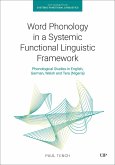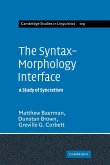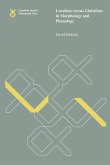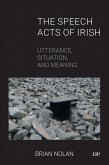V Evans, Benjamin K. Bergen, Jörg Zinken
The Cognitive Linguistics Reader
Herausgeber: Bergen, Benjamin K; Zinken, Jorg; Evans, Vyvyan
V Evans, Benjamin K. Bergen, Jörg Zinken
The Cognitive Linguistics Reader
Herausgeber: Bergen, Benjamin K; Zinken, Jorg; Evans, Vyvyan
- Broschiertes Buch
- Merkliste
- Auf die Merkliste
- Bewerten Bewerten
- Teilen
- Produkt teilen
- Produkterinnerung
- Produkterinnerung
Cognitive Linguistics is the most rapidly expanding school in modern Linguistics. It aims to create a scientific approach to the study of language, incorporating the tools of philosophy, neuroscience and computer science. Cognitive approaches to language were initially based on philosophical thinking about the mind, but more recent work emphasizes the importance of convergent evidence from a broad empirical and methodological base.
Andere Kunden interessierten sich auch für
![Word Phonology in a Systemic Functional Linguistic Framework Word Phonology in a Systemic Functional Linguistic Framework]() Paul TenchWord Phonology in a Systemic Functional Linguistic Framework30,99 €
Paul TenchWord Phonology in a Systemic Functional Linguistic Framework30,99 €![The Gender of Substantives in the French Language The Gender of Substantives in the French Language]() Alexander StrouwelleThe Gender of Substantives in the French Language15,99 €
Alexander StrouwelleThe Gender of Substantives in the French Language15,99 €![Morphology Morphology]() Antonio FábregasMorphology40,99 €
Antonio FábregasMorphology40,99 €![Contrastive Linguistics Contrastive Linguistics]() Sushma GoelContrastive Linguistics21,99 €
Sushma GoelContrastive Linguistics21,99 €![The Syntax-Morphology Interface The Syntax-Morphology Interface]() Matthew BaermanThe Syntax-Morphology Interface59,99 €
Matthew BaermanThe Syntax-Morphology Interface59,99 €![Localism Versus Globalism in Morphology and Phonology Localism Versus Globalism in Morphology and Phonology]() David EmbickLocalism Versus Globalism in Morphology and Phonology34,99 €
David EmbickLocalism Versus Globalism in Morphology and Phonology34,99 €![The Speech Acts of Irish The Speech Acts of Irish]() Brian NolanThe Speech Acts of Irish30,99 €
Brian NolanThe Speech Acts of Irish30,99 €-
-
-
Cognitive Linguistics is the most rapidly expanding school in modern Linguistics. It aims to create a scientific approach to the study of language, incorporating the tools of philosophy, neuroscience and computer science. Cognitive approaches to language were initially based on philosophical thinking about the mind, but more recent work emphasizes the importance of convergent evidence from a broad empirical and methodological base.
Produktdetails
- Produktdetails
- Verlag: Equinox Publishing
- Seitenzahl: 672
- Erscheinungstermin: 1. Oktober 2007
- Englisch
- Abmessung: 244mm x 169mm x 50mm
- Gewicht: 1660g
- ISBN-13: 9781845531102
- ISBN-10: 1845531108
- Artikelnr.: 21246972
- Herstellerkennzeichnung
- Libri GmbH
- Europaallee 1
- 36244 Bad Hersfeld
- gpsr@libri.de
- Verlag: Equinox Publishing
- Seitenzahl: 672
- Erscheinungstermin: 1. Oktober 2007
- Englisch
- Abmessung: 244mm x 169mm x 50mm
- Gewicht: 1660g
- ISBN-13: 9781845531102
- ISBN-10: 1845531108
- Artikelnr.: 21246972
- Herstellerkennzeichnung
- Libri GmbH
- Europaallee 1
- 36244 Bad Hersfeld
- gpsr@libri.de
Introduction
I. Overview
1. The Cognitive Linguistics Enterprise: An Overview Vyvyan Evans, Benjamin
K. Bergen and Jörg Zinken
II. Empirical Methods in Cognitive Linguistics
Introduction
2. Why Cognitive Linguists Should Care More about Empirical Methods
Raymond W. Gibbs
3. Towards an Empirical Lexical Semantics Hubert Cuyckens, Sandra Dominiek
and Sally Rice
4. Collostructions: Investigating the Interaction of Words and
Constructions Anatol Stefanowitsch and Stefan Thomas Gries
5. Conceptual Integration and Metaphor: An Event-related Potential Study
Seana Coulson and Cyma Van Petten
III. Prototypes, Polysemy and Word-meaning
Introduction
6. Cognitive Models and Prototype Theory George Lakoff
7. Where does Prototypicality Come from? Dirk Geeraerts
8. Reconsidering Prepositional Polysemy Networks: The Case of OVER Andrea
Tyler and Vyvyan Evans
9. Frame Semantics Charles Fillmore
IV. Metaphor, Metonymy and Blending
Introduction
10. The Contemporary Theory of Metaphor George Lakoff
11. A Typology of Motivation for Conceptual Metaphor: Correlation vs.
Resemblance Joseph Grady
12. Towards a Theory of Metonymy Günter Radden and Zoltán Kövecses
13. Conceptual Integration Networks Gilles Fauconnier and Mark Turner
14. Blending and Metaphor Joseph E. Grady, Todd Oakley and Seana Coulson
V. Cognitive Approaches to Grammar
15. An Introduction to Cognitive Grammar Ronald W. Langacker
16. The Relations of Grammar to Cognition Leonard Talmy
17. Regularity and Idiomaticity: The Case of LET ALONE Charles Fillmore,
Paul Kay and Mary Catherine O’Connor
18. Constructions: A New Theoretical Approach to Language Adele Goldberg
19. Embodied Construction Grammar in Simulation-based Language
Understanding Benjamin K. Bergen and Nancy Chang
20. Logical and Typological Arguments for Radical Construction Grammar
William Croft
VI. Conceptual Structure in Language
21. Force Dynamics in Language and Cognition Leonard Talmy
22. How we Conceptualise Time: Language, Meaning and Temporal Cognition
Vyvyan Evans
23. How Language Structures Space Leonard Talmy
VII. Language Acquisition, Diversity and Change
24. A Usage-based Approach to Child Language Acquisition Michael Tomasello
25. Space Under Construction: Language-specific Spatial Categorization in
First Language Acquisition Melissa Bowerman and Soonja Choi
26. Does Language Shape Thought? English and Mandarin Speakers’ Conceptions
of Time Lera Boroditsky
27. Language and Thought Online: Cognitive Consequences of Linguistic
Relativity Dan Slobin
28. Linguistic Selection: An Utterance-based Evolutionary Theory of
Language William Croft
Annotated Further Reading
I. Overview
1. The Cognitive Linguistics Enterprise: An Overview Vyvyan Evans, Benjamin
K. Bergen and Jörg Zinken
II. Empirical Methods in Cognitive Linguistics
Introduction
2. Why Cognitive Linguists Should Care More about Empirical Methods
Raymond W. Gibbs
3. Towards an Empirical Lexical Semantics Hubert Cuyckens, Sandra Dominiek
and Sally Rice
4. Collostructions: Investigating the Interaction of Words and
Constructions Anatol Stefanowitsch and Stefan Thomas Gries
5. Conceptual Integration and Metaphor: An Event-related Potential Study
Seana Coulson and Cyma Van Petten
III. Prototypes, Polysemy and Word-meaning
Introduction
6. Cognitive Models and Prototype Theory George Lakoff
7. Where does Prototypicality Come from? Dirk Geeraerts
8. Reconsidering Prepositional Polysemy Networks: The Case of OVER Andrea
Tyler and Vyvyan Evans
9. Frame Semantics Charles Fillmore
IV. Metaphor, Metonymy and Blending
Introduction
10. The Contemporary Theory of Metaphor George Lakoff
11. A Typology of Motivation for Conceptual Metaphor: Correlation vs.
Resemblance Joseph Grady
12. Towards a Theory of Metonymy Günter Radden and Zoltán Kövecses
13. Conceptual Integration Networks Gilles Fauconnier and Mark Turner
14. Blending and Metaphor Joseph E. Grady, Todd Oakley and Seana Coulson
V. Cognitive Approaches to Grammar
15. An Introduction to Cognitive Grammar Ronald W. Langacker
16. The Relations of Grammar to Cognition Leonard Talmy
17. Regularity and Idiomaticity: The Case of LET ALONE Charles Fillmore,
Paul Kay and Mary Catherine O’Connor
18. Constructions: A New Theoretical Approach to Language Adele Goldberg
19. Embodied Construction Grammar in Simulation-based Language
Understanding Benjamin K. Bergen and Nancy Chang
20. Logical and Typological Arguments for Radical Construction Grammar
William Croft
VI. Conceptual Structure in Language
21. Force Dynamics in Language and Cognition Leonard Talmy
22. How we Conceptualise Time: Language, Meaning and Temporal Cognition
Vyvyan Evans
23. How Language Structures Space Leonard Talmy
VII. Language Acquisition, Diversity and Change
24. A Usage-based Approach to Child Language Acquisition Michael Tomasello
25. Space Under Construction: Language-specific Spatial Categorization in
First Language Acquisition Melissa Bowerman and Soonja Choi
26. Does Language Shape Thought? English and Mandarin Speakers’ Conceptions
of Time Lera Boroditsky
27. Language and Thought Online: Cognitive Consequences of Linguistic
Relativity Dan Slobin
28. Linguistic Selection: An Utterance-based Evolutionary Theory of
Language William Croft
Annotated Further Reading
Introduction
I. Overview
1. The Cognitive Linguistics Enterprise: An Overview Vyvyan Evans, Benjamin
K. Bergen and Jörg Zinken
II. Empirical Methods in Cognitive Linguistics
Introduction
2. Why Cognitive Linguists Should Care More about Empirical Methods
Raymond W. Gibbs
3. Towards an Empirical Lexical Semantics Hubert Cuyckens, Sandra Dominiek
and Sally Rice
4. Collostructions: Investigating the Interaction of Words and
Constructions Anatol Stefanowitsch and Stefan Thomas Gries
5. Conceptual Integration and Metaphor: An Event-related Potential Study
Seana Coulson and Cyma Van Petten
III. Prototypes, Polysemy and Word-meaning
Introduction
6. Cognitive Models and Prototype Theory George Lakoff
7. Where does Prototypicality Come from? Dirk Geeraerts
8. Reconsidering Prepositional Polysemy Networks: The Case of OVER Andrea
Tyler and Vyvyan Evans
9. Frame Semantics Charles Fillmore
IV. Metaphor, Metonymy and Blending
Introduction
10. The Contemporary Theory of Metaphor George Lakoff
11. A Typology of Motivation for Conceptual Metaphor: Correlation vs.
Resemblance Joseph Grady
12. Towards a Theory of Metonymy Günter Radden and Zoltán Kövecses
13. Conceptual Integration Networks Gilles Fauconnier and Mark Turner
14. Blending and Metaphor Joseph E. Grady, Todd Oakley and Seana Coulson
V. Cognitive Approaches to Grammar
15. An Introduction to Cognitive Grammar Ronald W. Langacker
16. The Relations of Grammar to Cognition Leonard Talmy
17. Regularity and Idiomaticity: The Case of LET ALONE Charles Fillmore,
Paul Kay and Mary Catherine O’Connor
18. Constructions: A New Theoretical Approach to Language Adele Goldberg
19. Embodied Construction Grammar in Simulation-based Language
Understanding Benjamin K. Bergen and Nancy Chang
20. Logical and Typological Arguments for Radical Construction Grammar
William Croft
VI. Conceptual Structure in Language
21. Force Dynamics in Language and Cognition Leonard Talmy
22. How we Conceptualise Time: Language, Meaning and Temporal Cognition
Vyvyan Evans
23. How Language Structures Space Leonard Talmy
VII. Language Acquisition, Diversity and Change
24. A Usage-based Approach to Child Language Acquisition Michael Tomasello
25. Space Under Construction: Language-specific Spatial Categorization in
First Language Acquisition Melissa Bowerman and Soonja Choi
26. Does Language Shape Thought? English and Mandarin Speakers’ Conceptions
of Time Lera Boroditsky
27. Language and Thought Online: Cognitive Consequences of Linguistic
Relativity Dan Slobin
28. Linguistic Selection: An Utterance-based Evolutionary Theory of
Language William Croft
Annotated Further Reading
I. Overview
1. The Cognitive Linguistics Enterprise: An Overview Vyvyan Evans, Benjamin
K. Bergen and Jörg Zinken
II. Empirical Methods in Cognitive Linguistics
Introduction
2. Why Cognitive Linguists Should Care More about Empirical Methods
Raymond W. Gibbs
3. Towards an Empirical Lexical Semantics Hubert Cuyckens, Sandra Dominiek
and Sally Rice
4. Collostructions: Investigating the Interaction of Words and
Constructions Anatol Stefanowitsch and Stefan Thomas Gries
5. Conceptual Integration and Metaphor: An Event-related Potential Study
Seana Coulson and Cyma Van Petten
III. Prototypes, Polysemy and Word-meaning
Introduction
6. Cognitive Models and Prototype Theory George Lakoff
7. Where does Prototypicality Come from? Dirk Geeraerts
8. Reconsidering Prepositional Polysemy Networks: The Case of OVER Andrea
Tyler and Vyvyan Evans
9. Frame Semantics Charles Fillmore
IV. Metaphor, Metonymy and Blending
Introduction
10. The Contemporary Theory of Metaphor George Lakoff
11. A Typology of Motivation for Conceptual Metaphor: Correlation vs.
Resemblance Joseph Grady
12. Towards a Theory of Metonymy Günter Radden and Zoltán Kövecses
13. Conceptual Integration Networks Gilles Fauconnier and Mark Turner
14. Blending and Metaphor Joseph E. Grady, Todd Oakley and Seana Coulson
V. Cognitive Approaches to Grammar
15. An Introduction to Cognitive Grammar Ronald W. Langacker
16. The Relations of Grammar to Cognition Leonard Talmy
17. Regularity and Idiomaticity: The Case of LET ALONE Charles Fillmore,
Paul Kay and Mary Catherine O’Connor
18. Constructions: A New Theoretical Approach to Language Adele Goldberg
19. Embodied Construction Grammar in Simulation-based Language
Understanding Benjamin K. Bergen and Nancy Chang
20. Logical and Typological Arguments for Radical Construction Grammar
William Croft
VI. Conceptual Structure in Language
21. Force Dynamics in Language and Cognition Leonard Talmy
22. How we Conceptualise Time: Language, Meaning and Temporal Cognition
Vyvyan Evans
23. How Language Structures Space Leonard Talmy
VII. Language Acquisition, Diversity and Change
24. A Usage-based Approach to Child Language Acquisition Michael Tomasello
25. Space Under Construction: Language-specific Spatial Categorization in
First Language Acquisition Melissa Bowerman and Soonja Choi
26. Does Language Shape Thought? English and Mandarin Speakers’ Conceptions
of Time Lera Boroditsky
27. Language and Thought Online: Cognitive Consequences of Linguistic
Relativity Dan Slobin
28. Linguistic Selection: An Utterance-based Evolutionary Theory of
Language William Croft
Annotated Further Reading








